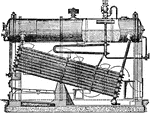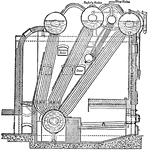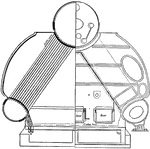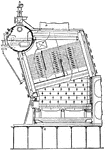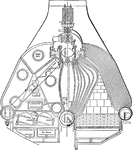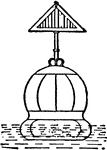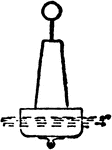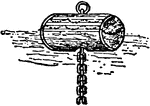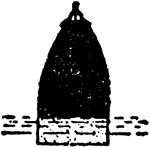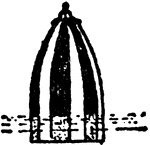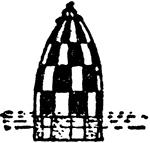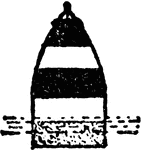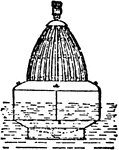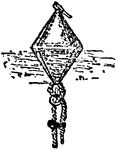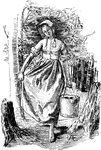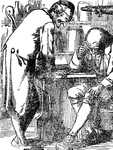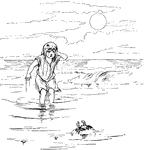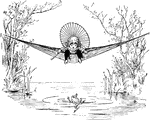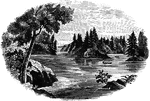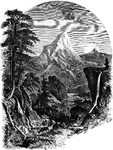Barometer
"Suppose a to be a long tube, with the piston b so nicely fitted to its inside, as to work air tight.…
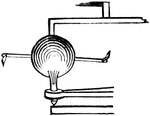
Hero's Machine
"Hero's Machine. The generation of steam from water by the application of heat, and the mechanical force…
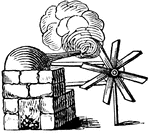
Brancas Engine
"In 1629 Giovanni Branca, an Italian, contrived a machine which was employed for the various purposes…

Savery Engine
"Savery's Steam Engine. The adjoining figure illustrates the apparatus employed by Savory. It consists…

Crank
"The simplest idea of a crank is that of a handle to a wheel; its action is familiarly illustrated in…
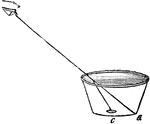
Cup and Shilling
"The refraction of water is beautifully proved by the following simple experiment. Place an empty cup,…
Tides
"Let m be the Moon, and E the Earth covered with water. As the Moon passes round the Earth, its solid…
Neap Tides
"The elevation of the tides at c and d is produced by the causes already explained; but their elevation…
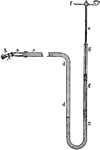
Manometer
"Mercury manometer for recording blood-pressure. d g, glass U-tube partly filled with mercury. In one…

Mosquito Eggs
"Eggs of mosquitoes. A, Culex; B, Anopheles photographed on the water, natural size." —Davison,…
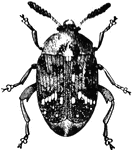
Pea Weevil
"Pea weevil; adult. The pea weevil (Bruchus) is often found in peas in its larval state during summer…

Pea Weevil
"Pea weevil; pupa. The pea weevil (Bruchus) is often found in peas in its larval state during summer…

Daphnia
"The water fleas just visible to the naked eye are present in nearly all waters and become very abundant…
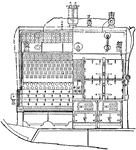
Babcock and Wilcox Water-tube Boiler
Babcock and Wilcox Water-tube Boiler, section at AB-front elevation

Regnaults Manometer
"AB is a strong metal tube, closed at the lower end, and carrying at the upper a bent pipe for admitting…

Microscope
"For a laboratory microscope, the pattern represented here has been found very convienient, —the…
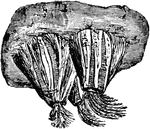
Barnacles
A white or brown arthropoda. Has a pair of cirri, which form a net used to scoop food particles out…
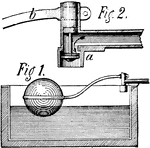
Ball Cock
A hollow sphere of ball attached to the end of a lever, which turns the stop—cock of a water pipe…
Buffalo Gnat Larva
The larva is curious little creatures, living under water in rather swiftly flowing streams, clinging…

Buffalo Gnat Pupa
The larva are curious little creatures, living under water in rather swiftly flowing streams, clinging…
Horse Fly Larva
The larvae are elongated, somewhat flattened creatures, some living in the soil, some in water, and…
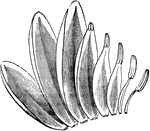
White Water-Lily
Series of sepals, petals, and stamens of White Water-Lily, showing the transitions.

Alga
Magnified view of some of a simple fresh water Alga, the Tetraspora lubrica, each sphere of which may…

Cicada Septendecim
Also known as the Seventeen-Year Locust, derives its specific name from the fact that it makes its appearance…
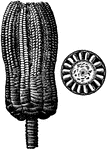
Fossil Encrinite
When the remains of an animal or plant are exposed to the air or buried in dry earth, they generally…
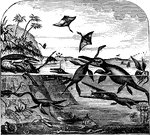
Reptiles
In this age the animals and plants begin to resemble existing species. The age is characterized mainly…

Amazon River
The Amazon River is the largest, most voluminous river on earth, having a greater total flow than the…
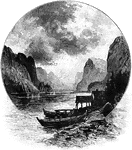
Fiords on Norway Coast
Fiords are valleys that were deeply eroded by slowly moving masses of ice called glaciers, subsequently…
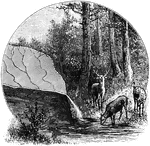
Origin of Springs
A spring is a point where groundwater flows from the ground, and is thus where the aquifer surface meets…
